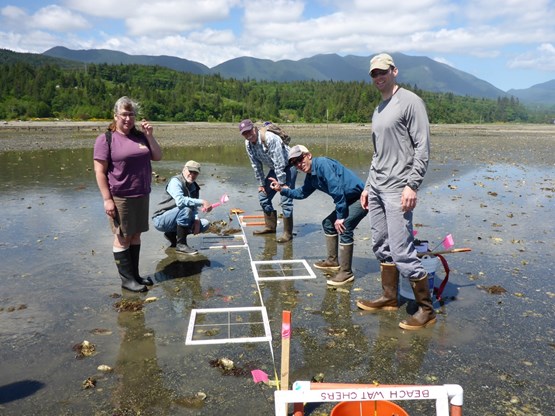Olympia oysters (Ostrea lurida) are ecosystem engineers, forming complex carpets of overlapping shell that provides hiding places and feeding opportunities for a diverse community of nearshore species. The Olympia oyster is the only native oyster from British Columbia to Baja California. Due to habitat loss and overharvesting, their populations are a mere fraction of what they once were prior to the arrival of settlers in the mid-1800s. Scattered individual Olympias can still be found in bays across East Jefferson County, including one small but persistent population located in South Discovery Bay where the Jefferson MRC is working to enhance Olympia oyster habitat.
Project Overview
The MRC has been working for over 10 years to protect the Discovery Bay population and restore Olympia oysters to local waters. In the early years, our work included surveys, education outreach, and monitoring studies in Discovery Bay. In 2006, the MRC began monitoring the population in Discovery Bay, recording information about geographic location, estimated numbers of individuals, size distribution, age, and larval settlement.
In 2014, the MRC launched a habitat enhancement project near a stable but small population of Olympia oysters. This extant population was doing well, but had not expanded much due to limited availability of suitable substrate in the area. We wanted to test the effectiveness of "light touch" restoration by adding a thin layer of scattered clean Pacific oyster shells (not seeded with oyster spat). In August 2014, volunteers spread clean shell onto ¼ acre of tideflats nearby, at what we call the Powerlines Site. Larvae released from the nearby population settled on this shell in 2015 and 2016. Additional shell was added to the project site in 2016 to replace the shell that the currents and wave action had moved southwards.
MRC volunteers have been monitoring this site every year, observing continued recruitment and growth of Olympia oysters. In 2019, we added clean oyster shells to a new area nearby, at what we call the "Lagoon Site", and we have been observing successful recruitment here as well. We added additional shell to both sites in 2020 and 2021, and to just the Lagoon Site in 2022. In 2022, we expanded the Powerlines Site to include a parcel located adjacent and southwest of it, and will be distinguishing the two as the North and South Powerlines Sites. Over the years, we'll continue to add clean shell as needed and monitor settlement and growth each year at all three sites.
See the 2023 Olympia oyster project summary report here.
Project partners include the Jamestown S'Klallam Tribe, WA Department of Fish and Wildlife, Puget Sound Restoration Fund, WSU Extension Beach Naturalists, and others.


